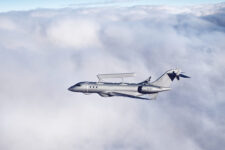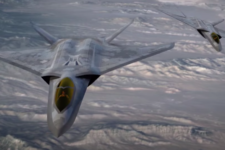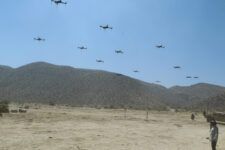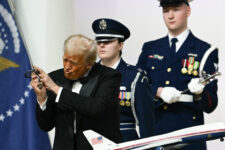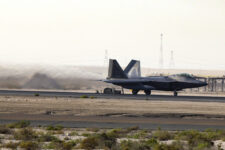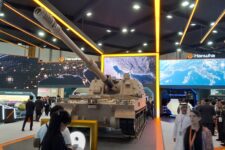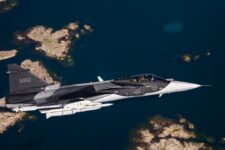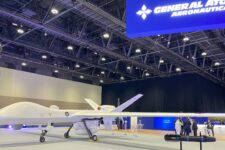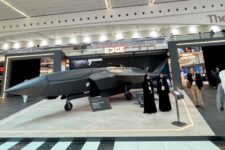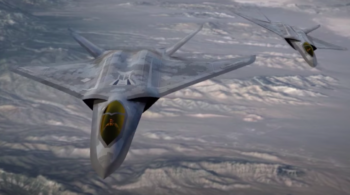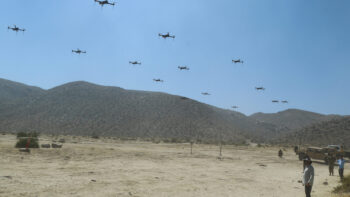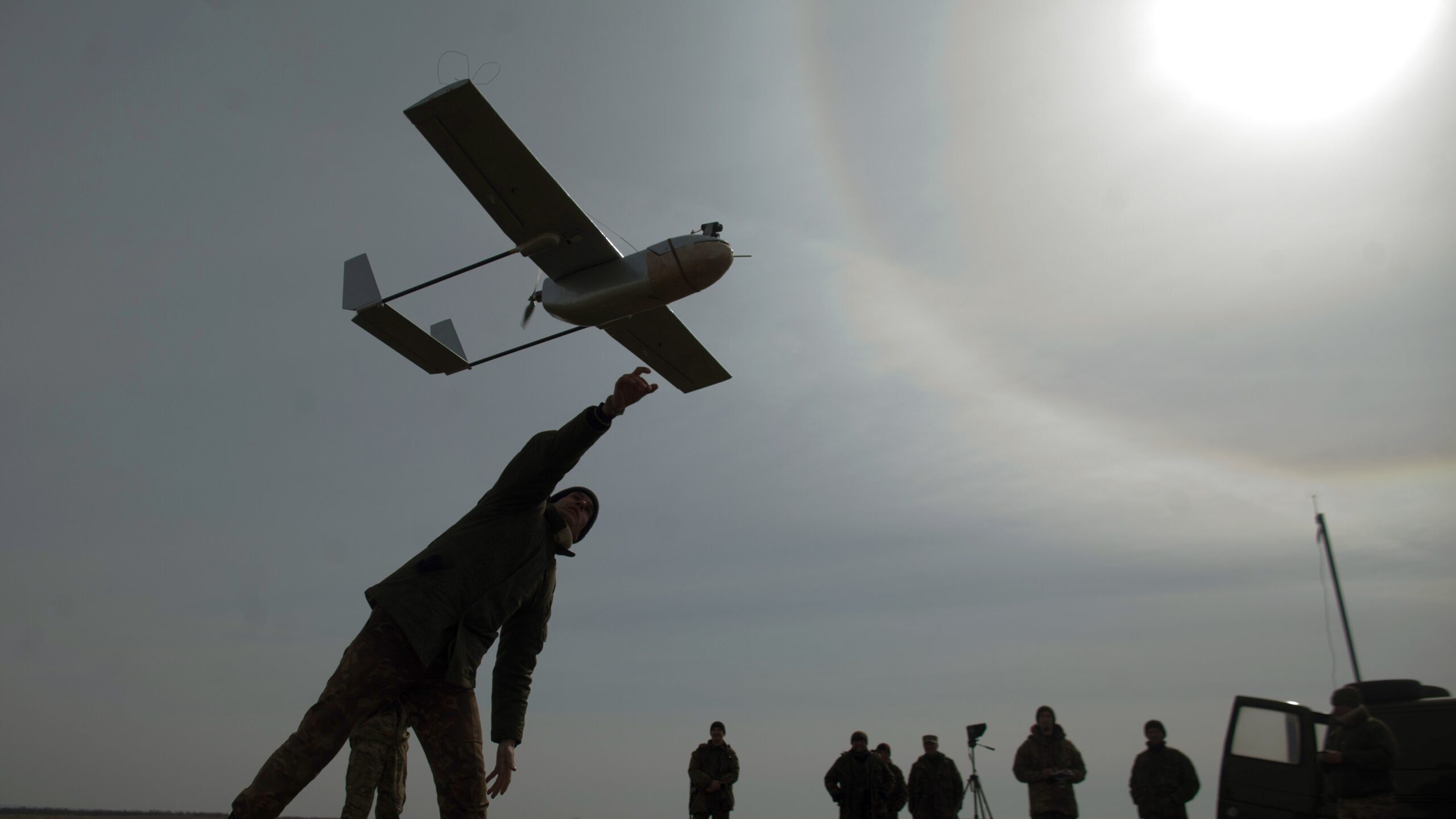
A serviceman launches an unmanned reconnaissance aircraft at the position of the Ukrainian forces near eastern Ukrainian city of Lysychansk,(Petro Zadorozhnyy/AFP via Getty Images)
As cheap, unmanned drones proliferate on both sides of the Ukraine conflict, new air superiority tactics are emerging almost daily. In the op-ed below, the Stimson Center’s Kelly Grieco and the Atlantic Council’s Julia Siegel describe how the new era of aerial warfare could favor a savvy Taiwan, should China decide to invade.
Seven months after Russia’s full-scale invasion, the skies over Ukraine remain contested. Few military pundits saw it coming, predicting the Ukrainians stood little chance of defending their airspace. Moscow, too, believed its larger and more technologically sophisticated aerospace forces would quickly seize air superiority and expected to secure a decisive battlefield victory.
But in war, nothing is easy or inevitable. Rather than experience a quick defeat, Kyiv has stayed in the fight and landed a few hard blows to Moscow’s invading forces. Ukraine’s defense ought to inspire Taiwan to follow a similar path, should it face down a similar threat from Beijing.
The conventional wisdom in Washington now holds that if China chooses to invade Taiwan, it would likely “go big and move fast” in an attempt to conquer the island before the United States and its allies arrive. The underlying assumption is that Taiwan’s military would be unable to halt a Chinese incursion without the United States intervening directly and quickly.
However, a Chinese invasion of Taiwan is neither imminent nor inevitable. Indeed, the majority of Chinese experts assess that Xi Jinping believes peaceful unification is still possible. Moreover, Taiwan has the defender’s advantage—it does not need to win outright, it merely needs to deny China a quick victory.
And the key to denying a Chinese victory lays in the air domain: Without the cover of air superiority, China would be unlikely to succeed in the event of an amphibious invasion or enforced blockade of the island.
Ukraine offers many lessons for Taiwan in a potential conflict scenario, and Taipei ought to carefully study Kyiv’s air and space playbook in particular and be cautious in taking the right lessons forward. China and Russia pose inherently different threats, given their distinct geographies, military capabilities, doctrines and strategic interests.
While Ukraine, the second-largest country in Europe, shares a land border with several US allies, Taiwan is not only about 1/17th the size of Ukraine but it is also an island nation. Taipei will need to adapt its approach to reflect its lack of strategic depth and natural barriers to easy resupply, as well as China’s large arsenal of precision long-range strike weapons.
Still, three core takeaways are particularly relevant to Taiwan’s defense.
1. Small air forces can now access and exploit the air and space domains to battlefield advantage.
The democratization of air, space and intelligence capabilities — a result of low-cost and accessible technologies — has lowered barriers of entry into the air and space domains and removed traditional great-power military advantage. With allied help, Ukraine has leveraged commercial satellites in combat despite not owning national space capabilities, using them to successfully strike enemy forces and send encrypted messages back and forth between troops.
Similarly, Ukraine has exploited relatively cheap but still “good enough” combat drones—including the Turkish-made Bayraktar TB2—to locate and destroy expensive Russian military assets. Thousands of commercial drones, some modified to drop munitions, have further hampered Russian ground movements. By employing a mix of commercial and dual-use technologies together with more advanced military systems, Ukraine has managed to close the capability gap.
Taipei ought to take notice and seek to build a largely roboticized air force with precision-strike capabilities for itself. Taiwan has completed long-range flight tests of its domestically-built Ten Yung 2, a combat drone similar to the US MQ-1 Predator and recently announced the purchase of four MA-9B Sea Guardian, the maritime variant of the US MQ-9A Reaper. These nascent efforts are a step in the right direction, but they ought to be rapidly expanded and scaled up to gain an asymmetric advantage. Though Taiwan has traditionally prioritized smaller numbers of exquisite platforms, like F-16 fighters, it should prioritize cheaper, asymmetric capabilities to combat China.
2. The return of mass to air and space operations favors the defender because it is easier to deny air and space superiority than it is to gain it outright.
After many decades of the United States and Western air forces substituting stealth aircraft, space-based information advantages and precision weapons for superior numbers, the relationship between quantity and quality is now moving in the opposite direction. As the Soviet dictator Joseph Stalin reputedly quipped, “quantity has a quality all its own,” and that’s becoming true in the modern aerial battlefield.
The advantage now lies with cheap mass. Operating a mix of Cold War era, Soviet-made mobile surface-to-air missile systems, anti-aircraft artillery and thousands of shoulder-fired man-portable air defense systems, including American-supplied Stingers, Ukraine has managed to deny air superiority to the Russians. Employing so-called shoot-and-scoot tactics, Ukrainian defenders have made it difficult for Russians to find and destroy them.
This combination of mobility and layered mass, from high to low altitudes, has allowed Ukraine to survive Russia’s air and missile strikes and keep the airspace contested. Without air superiority, Russia’s ground offensive cannot succeed — after all, an attacker must concentrate and move to achieve its goals, making it extremely vulnerable to air attacks.
Taking a page from Ukraine’s playbook, Taiwan ought to develop concepts and capabilities for employing sufficiently large numbers of smaller, cheaper, uncrewed systems in a distributed way to increase both the costs and uncertainty associated with Chinese military aggression.
If China chose to invade Taiwan, Chinese aircraft and missiles would attempt to target and overwhelm military command and control systems at the outset, so as to leave the island in a blind fight. If Taiwan employs a distributed defense, however, enough Taiwanese systems would likely survive the initial onslaught and then be able to challenge Chinese forces attempting to cross the Taiwan Strait. This force posture would thus give Taiwan a more credible deterrent by denial.
3. Robust international and cross-sector partnerships can be a “force multiplier” in countering an adversary’s relative military advantages in air and space capabilities.
Ukraine has exploited a strong web of commercial partnerships and international coalition support to military advantage. Russian cyber efforts have had limited success, at least in part because of the breadth and depth of Kyiv’s network of supporters. For example, after observing a Russian military intelligence operation in progress, Microsoft worked with Ukrainian cyber defenders and US government partners to stop the attack.
In the space domain, Ukraine has shown that access to satellite service matters more than ownership of the satellite itself. Public-private partnerships will likely become even more central to warfighting as scalable dual-use technologies increasingly shape the battlefield.
Taiwan is well-placed to exploit this trend, given its strong information and telecommunications, semiconductor and advanced manufacturing industries. These robust commercial and international networks will be critical for Taiwan’s ability to generate mass and sustain capacity should it find itself in a prolonged war of attrition with China. While Taiwan’s island geography makes resupply more challenging, partnership networks can be leveraged for stockpiling critical supplies and putting redundant infrastructure in place during peacetime.
Each of these key takeaways suggest Taiwan ought to invest in what’s popularly known as a porcupine defense, with an air force built around large numbers of cheap and mobile systems, trained on air denial concepts and tactics, and intertwined in robust international and public-private partnerships to meet potential wartime demands.
While Taipei recently announced a major increase in defense spending for next year, its total defense budget of about $19.4 billion is still only equivalent to about 2.4 percent of its projected gross domestic product. Taiwan’s investment in its own military’s future ought to match the urgency of the issue—fielding next-generation drones and similarly flexible and dispersible systems can deny China a quick win at a reasonable dollar cost.
A readied Taiwanese air force that can deny China a quick victory is the best guarantor of Taiwanese sovereignty, for it ought to cause Beijing to think twice about attempting an invasion in the first place.
Kelly A. Grieco is a senior fellow with the Stimson Center’s Reimagining US Grand Strategy Program. Julia Siegel is an assistant director in the Forward Defense practice of the Atlantic Council’s Scowcroft Center for Strategy and Security. This article is based on Grieco and Siegel’s overview article for the Atlantic Council’s “Airpower After Ukraine” series, which advances key themes of the Ukraine air war and implications for future air and space forces.



